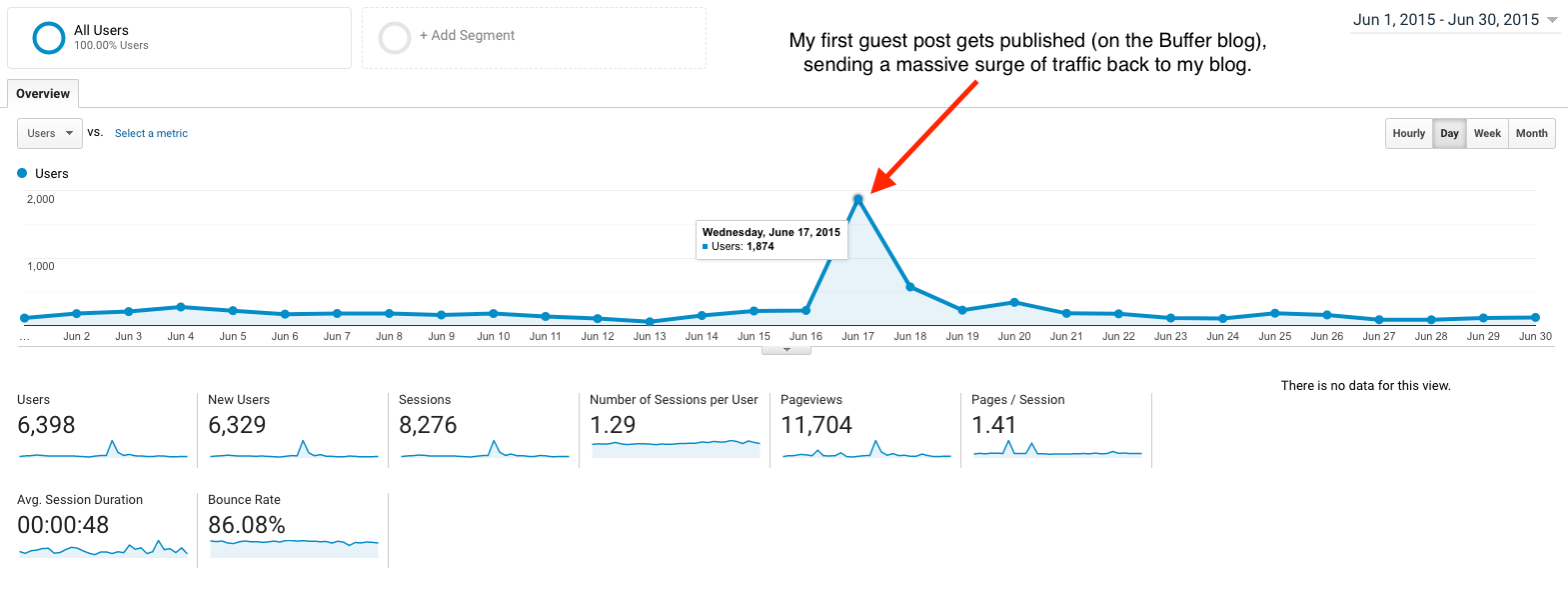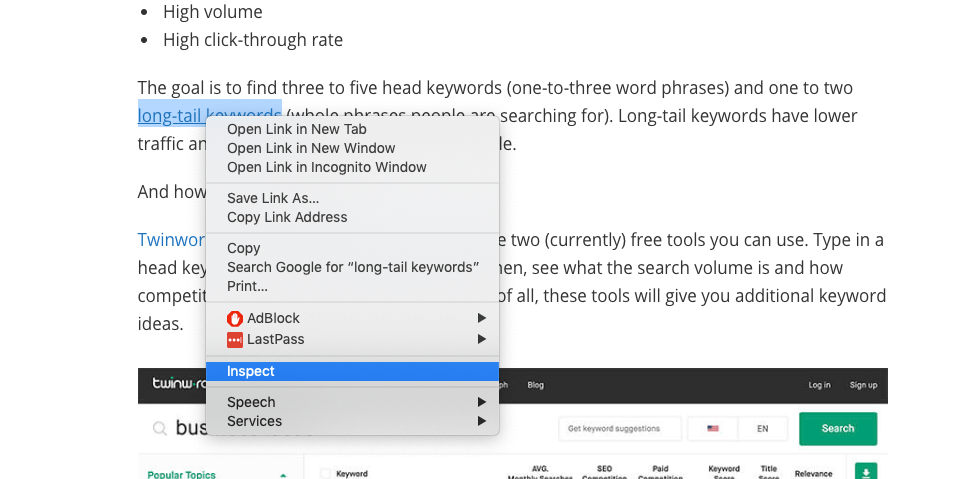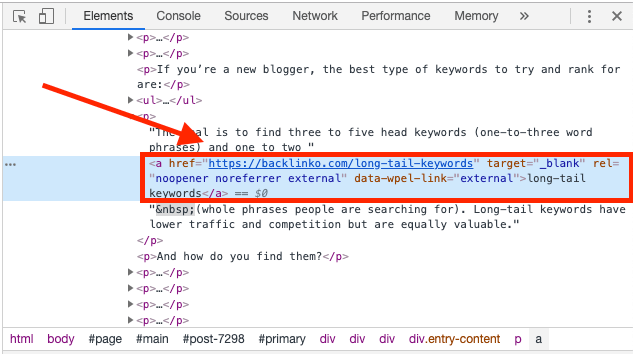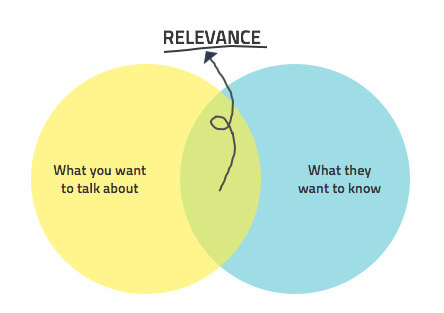With a high degree of certainty, guest blogging will be be one of the absolute best strategies to employ if you’d like an uptick in targeted traffic to your blog, higher search engine rankings and a stronger reputation in your niche… all for free.
It might sound like a pipe dream (especially if you’ve only recently started your blog), but it’s not. You can accomplish all of these feats surprisingly quickly, and without paying a dime—through guest blogging. Let’s talk about how to guest post.
What is Guest Blogging?
Guest blogging, also called guest posting, is when you write an article for someone else’s blog with the purpose of growing your brand, gaining exposure to your target audience, generating traffic and building natural backlinks for your own blog.
Although there are some exceptions, a guest post will normally be a unique piece of content you’ll have to write (or use a free AI article writer to help craft your first draft)—one you haven’t already published on your blog or anywhere else—and you’ll almost always be writing for a blog with a larger audience than your own (which is one of the major benefits of guest blogging).
You don’t have to pay to be a guest blogger, either. If you’re asked to pay, then that’s a sponsored post, not a guest post. In fact, some blogs will even pay you for guest blogging on their site.
So what’s the catch when it comes to guest blogging? Well, there isn’t one—and everybody still benefits.
Guest Blogging 101: How to Land a Guest Blog Post in 10 Easy Steps (2025)
- Nail your guest blogging prerequisites (first)
- How to find the perfect blogs to guest post on
- Come up with great guest blogging ideas
- Find and follow the guest blogging guidelines
- Learn how to pitch your guest blog post
- Write a guest blog post your host can’t resist
- Tastefully include links to your own content
- Craft a clever guest blog post bio for yourself
- What to do after your guest blog post goes live
- Clever ways to get even more from your guest blogging
Disclosure: Please note that some of the links below are affiliate links and at no additional cost to you, I’ll earn a commission. When you purchase a product or service using my one of my affiliate links, the company compensates me, which helps me run this blog and keep my content free of charge to you. Know that I also only recommend products I personally stand behind.
Want My Free Outreach Email Templates?
Grab my 3 most effective outreach email templates in both Google Doc and PDF format (100% free) and send better guest blogging pitch emails today.
"*" indicates required fields
Today, more than 70 million blog posts are published each month. It’s getting increasingly competitive to reach (and retain) a large blog audience.
Thus, guest blogging is a win for the host blog that’s publishing your guest post, because they get a free piece of content that they don’t have to either write themselves or pay a writer to compile.
You get your name, your words and links to your own blog surfaced prominently to potentially thousands or more readers. We’ll talk more about including links in your guest blog posts later on in this guide, because those are extremely valuable in terms of building your blog’s SEO authority.
Check out this massive spike in traffic I saw to my blog (1,874 readers in one day—far above my average at the time) after my very first guest post was published several years ago:

The readers of the blog you just guest posted for also win, because they get to read a great piece of content that likely presents a new perspective than they’re used to.
Guest blogging is a win-win-win situation, where everyone is better off as a result.
Of all the ways to drive traffic to your blog and build a returning audience over time, guest blogging is by far the highest return investment you can make.
Now, let’s dive into my ultimate guide to guest posting and talk about how to land a guest blog post (for SEO and traffic) this year.
1. Nail Your Guest Blogging Prerequisites (First)

Some would-be guest bloggers worry that they need to have a ton of blogging experience or a huge following of their own—before anyone’s going to even consider publishing their posts.
But, that’s simply not true.
If you want to get started with guest blogging today and see your work published on someone else’s blog, there are only two crucial prerequisites:
- You need to be able to write well. Be honest with yourself here: if you’re not very fluent in English, or if you struggle a lot with spelling and grammar, you may not yet be at the level where you’re ready to dive into guest blogging. If you do want to go ahead, then it’s worth finding a friend who can help out with a bit of editing, or you might even consider paying a professional editor to help polish your work before pitching a guest post.
- You need to choose your host blog wisely. This means picking a realistic blog or publication that already takes guest posts. And I know this might sound obvious, but aiming for the very biggest blog or publication in your niche with your very first try, will only let you down and set the wrong expectations when you’re first getting into guest blogging. With this incremental approach, you can also gain valuable experience before you pitch the blog of your dreams.
I’m a living testament to the truth of this approach in steadily growing my own blog over the years—and I’ve structured my entire blog business plan around this core blog strategy.
If you’re looking for a little more guidance with growing your blog, then pick up my free blog planner bundle that’s packed with templates and resources to help along the way.
You Don’t Need a Huge Personal Brand to Succeed at Guest Blogging
When I first started guest blogging few years ago and began to have my work published on other (much higher authority) blogs, I didn’t yet have a personal brand or reputation at all.
What I did have, however, was the ability to write a blog post that could tell a compelling story, draw readers in and also serve to help my host’s blogging goals. Having the growing skill of writing that you’re constantly working to improve—and the willingness to be persistent with your outreach efforts—will go a long way in helping your guest blogging campaigns succeed.
On top of that foundational writing ability, I started with pitching startups I’d either already worked with in some capacity through my day job (as a content marketer at CreativeLive) or companies that would at least be familiar with the brand of my employer.
I leveraged the most advantageous tool at my disposal (working for a globally recognized startup) to network my way into guest blogging opportunities at other similar companies.
You may not be in the same position as I was when I started guest blogging—but challenge yourself to use the tools you’ve got, to your advantage.
2. How to Find the Perfect Blogs to Guest Post On

If you Google “blogs that accept guest posts,” you’ll find lots and lots of lists.
Spoiler: This Isn’t the Best Way to Start Guest Blogging.
After all, you don’t need 150 random blogs that accept guest posts… you just need one high quality blog to start with, and you can progress from there.
Instead, think about the blogs that you already read that cover the same topic, or a similar one, to what your own blog talks about. These are great types of blogs to pitch because you’re already very familiar with their style and the types of content that they publish.
Better yet, check out the kinds of guest blogging opportunities available through high quality, hand-curated sites like Places to Guest Post and quote contribution marketplaces like Featured & Help a B2B Writer.
When evaluating a blog or website to pitch for accepting a guest post, you want a site that:
- You already have some sort of connection with. Perhaps you’ve commented on the blog before, chatted with the blogger on Twitter or even have a similar blog name to. Starting with some sort of simple connection can make it easier to get your guest post pitch looked at.
- Is larger than your own, but not ridiculously huge. Aim for a blog that’s roughly five to ten times the size of your own. If you have 100 email subscribers, aim for a blog with ~1,000. If you’re aiming for blogs (like Forbes) that are more like a thousand or more times the size of your own, that’s a bit too ambitious when you’re brand new to guest blogging.
- Is on-topic for you. While you might gain some benefits from writing for a blog about cats when your blog is all about gadgets, there’s not going to be a lot of audience crossover, so you shouldn’t expect to see much of a gain from that time investment.
- Has a somewhat similar writing style to yours. It’s fine to modify your style a bit to suit the blog you’re guest posting on, but if you’re normally very “out there” with lots of off-color jokes, and the blog you’re writing for is more conservative, you’ll either find that (a) they reject your post because your style isn’t a good fit or (b) you modify your style to suit them–and readers who click through to your blog come down with a fit of the vapors. Both situations result in a less than desirable outcome.
- You’re proud to be associated with. Avoid guest blogging on sites that have been heavily criticized in your niche (unless you want to show your support for them), and avoid blogs that don’t fit with your personal moral or ethical values. If you’re a staunch liberal, for instance, it doesn’t make much sense to write a blog post that’s strongly in favor of a conservative ideology. The content won’t come off as authentic, and you’ll probably regret the decision in the future anyway. Consider your fit from a design perspective too—if the blog you’re considering guest posting on feels old and outdated with their blog layout, but you take a bold and fresh perspective with your ideas, will that really be the right place to publish your work?
- Offers a do-follow link. This is usually the case, but look carefully at the guest blogging guidelines to make sure that your bio link (or in-post links) will be “do-follow” rather than “nofollow” (as a nofollow link won’t do anything to help your blog SEO efforts). If there’s nothing stated either way in the guidelines, check out a past guest blog post, scroll to the bio, right-click on it, and select “Inspect” (in Google Chrome) to see the HTML code for that hyperlinked text snippet. If you see the word “nofollow” within the HTML description of the link, then it’s a nofollow link. If it doesn’t explicitly say the word “nofollow,” then you’re good to go.
Inspect a link by right-clicking on the hyperlinked text you want to look at—and clicking the “Inspect” option like so:

This will open up the control panel on the right side (or bottom) of your browser window.
And then you’ll want to take a close look at the highlighted text that describes the nature of the link you’re inspecting.
Again, you’re looking for any mention of the word “nofollow” in the description. So if it’s not mentioned there, then the link is considered “dofollow” which passes SEO benefits to the destination link (i.e. a post you’re promoting on your own blog).

Of course, it’s crucial to first check that your target blog actually accepts guest posts—and if they do, whether or not they allow clickable links back to your own content too.
Look for things like:
- Different authors cropping up on the blog (bonus points if something like “guest blogger” or “guest post” is used to introduce their work). This doesn’t necessarily mean the blog will be open to unsolicited guest blogging submissions though, so don’t automatically assume the flood gates are open.
- A “guest post guidelines” page. In a moment, we’ll take a look at how to find this page, as many bloggers don’t make it particularly prominent.
- A note on the Contact or About page about guest blogging. Some bloggers will put a line here about whether they’re open/closed to guest posts at any given point.
Read the Guest Blogging Guidelines Before Submitting a Pitch
If a blog says they’re not accepting guest posts, don’t expect them to make an exception for you. However amazing your blog post idea is, you’ll want to spend your valuable time elsewhere.
This is also true if a blog says they only take guest posts by invitation—though in that case, you can potentially contact the blogger (if you have an existing relationship with them) and ask if they’d be willing to look at a blog post outline to get a feel for your style, or go through a mutual connection to get an introduction.
3. Come Up with Great Guest Blogging Ideas

Many new guest bloggers come up with a ton of clever ideas first, then only afterwards look for the right blogs that those ideas might be a good fit for.
In my experience, that’s not the best way to go about guest blogging.
Instead, you want to come up with ideas that are perfect for each and every target blog you’re going to reach out to… not just ideas that are a halfway decent fit for a hundred different blogs. Think bespoke, not off-the-rack.
To come up with a guest blogging idea that’s going to work perfectly for your prospective site, you’ll want to start by doing some keyword research using a free tool (like mine).
Use My Free Keyword Research Tool

Try my free AI-Powered Keyword Tool to get dozens of research-backed ideas for keywords & topics to write about on your blog today.
Next, follow these steps to curate your keyword-backed pitch to the editors you’ll be reaching out to:
- Read lots of recent posts on your target blog. If you’re not a regular reader (or if you used to read the blog but haven’t done so recently), you really need to get up to date with the type of content they’ve published recently. If your target blog often writes about blogging costs and web hosting-related topics, then you could pitch them on a guest post that covers more niche blog topics like the best cheap web hosting plans, offering up a review of the top monthly hosting plan options on the market, or exploring the free hosting plans out there—all of which could ladder up to a bigger piece they already have about the overall best web hosting plans for their readers.
- Make notes about these posts. What topics have they covered? How long are the blog posts, roughly? Do their posts tend to be high-level and strategic, or focused on specific tactics? Are the posts aimed at beginners or people with a lot of experience? All of this can help you hone your ideas appropriately.
- Look at the categories the blog covers, if these are listed in their navigation. You might want to pay attention to categories that haven’t had many (or any) posts recently. These could be good targets for content that fills a “gap” on the blog. Keep in mind, though, that a lack of recent posts in a particular category could signal that the blog has changed direction.
- Brainstorm a list of ideas. Don’t just come up with one or two blog post ideas… aim for at least five. Some of them might not be great: that doesn’t matter. You want to keep going till you get an idea that you think would be a perfect fit for that blog.
- Perfect your headlines. Be sure you’re taking care to learn how to write a headline for your guest post that’s in a style & tone your target site will resonate with. If not, then it’s likely they’re either decline your submission (because your guest post doesn’t sound like the right fit), or substantially rewrite it before publishing. Use my free blog title generator to come up with AI-powered headline ideas that’ll capture your host blog’s attention.
Only after you’ve met this criteria, will you be ready to implement a guest blogging strategy that actually sees you getting published.
4. Find and Follow the Guest Blogging Guidelines

Most blogs that accept guest posts will have clear guidelines that they ask guest bloggers to follow.
Make sure you look for these… and follow them carefully before submitting your articles for consideration.
You’ll most likely find the guest post guidelines:
- Linked to from the blog’s About, Contact or Guest Post submission page
- Linked to from the sidebar or the footer of the blog
If they’re not in either of those places, search for “guest post guidelines”, “write for us,” “submit a post,” or “guest posting” on the site. To do this site search, you can type the phrase plus site:[nameoftargetblog.com] into Google, e.g. “guest post guidelines site:ryrob.com” and get more accurate results.
Guest post guidelines vary from blog to blog, but most will cover:
- The type of content they do/don’t accept. This will often be common sense (e.g. they don’t want plagiarized content or posts you’ve already published somewhere else), but the guidelines may also cover the topics they’re particularly interested in, or topics that they don’t want right now.
- Whether they want you to send them an idea and outline, or a full draft. It’s best to stick to what the blog asks for here (though most won’t reject you just because you sent the wrong thing).
- Who to send your pitch (or draft) to. This may be an editor, assistant or even a submission form rather than the blog owner.
- How to format and send your guest post. Some blogs like a Word document, others will want a Google doc, and a few still ask for raw HTML (though this is becoming increasingly rare). You may be given instructions on how to use headings.
Successful Guest Blogging Requires Following Instructions
There may also be other instructions (i.e. some blogs will ask you to submit your guest post using a specific form, or to use a specific subject line for your email to them).
Make sure you follow these guidelines, as failing to do so could mean your pitch never even gets seen. And if you need some help on the writing front, grab my free blog post templates to jumpstart your process.
If you’re struggling to find guest post guidelines, or if the guidelines don’t make it clear who to contact, I’ve got some actionable tips in this guide to blogger outreach about tracking down the right person to contact (and finding their email address).
5. Learn How to Pitch Your Guest Blog Post

Some blogs are happy to be contacted with a full draft of your guest blog post, but many want you to “pitch” the idea first. That’s where smart blogger outreach comes into play.
This normally means writing them an email where you briefly introduce yourself and your credentials, share your suggested guest blogging idea or prepared a great blog title, and outline what your post will be about.
Want My Free Outreach Email Templates?
Grab my 3 most effective outreach email templates in both Google Doc and PDF format (100% free) and send better guest blogging pitch emails today.
"*" indicates required fields
Here’s a copy and paste email template you can use for your guest post pitches (and you can grab a couple more outreach email templates above here ☝️):
Subject Line: Guest post for your blog
Hi [First Name],
Would you be interested in a guest post titled [title of suggested post]? I was thinking it’d cover:
[three to five bullet points covering the key points of your post]
If that sounds like it could be a good fit, I’d be happy to send you a full draft to take a look at.
Alternatively, another couple of posts I had in mind are [title of second post] or [title of third post]. Just let me know if either of those sounds like a better fit: I can whip up a quick outline to send over if you’re interested 🙂
I blog at [name of your site] about [topic], and [details of your credentials, if any – e.g. “I’ve been a WordPress developer since 2014”]. If this sounds like a good fit, I’d of course promote my guest post out to my (growing) audience on [social media channel you frequent, or approximate size of your email list].
Let me know what you think,
[Your Name]
While this guest blogging pitch is pretty simple and straightforward, there are definitely more nuanced and longer-term relationship building approaches you can take to your outreach as a whole. I highly recommend going through my complete guide to doing smart blogger outreach today.
Always Strive for a Simple Guest Blogging Pitch Email
You don’t need to make your guest post email pitch any more complicated than this. Keep it short, sweet and straight to the point.
The host blogger isn’t going to want to wade through five paragraphs about your own story—however intriguing it is—before you get to the details that are pertinent to them.
Similarly, there’s no point sending an incredibly detailed outline at this stage: if the blogger wants you to go into more detail, they’ll just ask.
6. Write a Guest Blog Post Your Host Can’t Resist

No host blog is going to give you a definite “yes” based on a pitch alone.
Even if your guest blogging idea was amazing, they need to see that you can deliver a strong piece of content that’s relevant to their target audience, matches their style and accomplishes some sort of strategic content marketing goal for them.
When you submit your draft guest post, it goes without saying that it should be your best work—especially if this guest blogging opportunity is on a site that can really change things for you.
Your Guest Blog Post Should Be Worthy of Publishing on Your Own Blog
One way to think about just how you should feel about the quality of your guest post—is to use the bar of making sure it’s up to standards to be a fully ready, top-notch article you’d happily publish on your own blog too.
Yes, you’re calling your guest post submission a “draft” in your pitch, but that’s because you want the host blog to feel free to ask for extensive changes if they feel you haven’t quite hit the mark. From your perspective though, this should be a polished piece of work that’s ready to publish as-is in your mind.
As well as doing a great job with the writing of the post itself, you want to make sure that:
- You’ve made your post as valuable as possible to readers. That could mean including examples, adding key blogging tips from the pros, linking to further reading, quoting from industry experts, compiling a free template… doing whatever you can to make your guest post truly useful and helpful. (Don’t go too far: if your host blog normally publishes 800 word posts, you don’t want to send them a 3,000 word monster like my roundup of 25 honest Bluehost reviews, unless that’s already been cleared by their team).
- You’ve made it as valuable as possible to the host blog. That means not just producing a great piece of content, but making sure that it helps your host blog out in some way. Normally, this means linking internally to other pillar content on their blog (aim to link to at least two or three of their posts), but it might also mean mentioning their products or their suggesting they opt-in to emails.
Either way, if you can somehow successfully tie your guest blogging efforts into a clear win for the host blog & their readers, then you’re much more likely to get a pitch accepted.
7. Tastefully Include Links to Your Own Content

Almost all host blogs will let you write your own bio, where you can at least include one link (often multiple) to wherever you want.
If they don’t allow you to include even a bio link to your own blog in a guest post, then I’d recommend not guest blogging for them as you likely aren’t getting anything in return for creating a solid piece of (free) content for them. Guest blogging needs to be a win-win-win in my opinion.
We’re going to talk more about bios in a moment—but in terms of the body of your guest post itself, you might be wondering whether it’s fine to link to your own content.
Can You Link to Your Own Blog Within a Guest Blog Post?
The answer is yes, you can usually link to your own content from a guest post when it’s done tastefully and has a clear purpose other than just giving yourself a random link. But, it comes with a bit of nuance.
Most blogs will be happy with you linking a few times to your own content, so long as it’s:
- Relevant: Don’t force a link to content that’s only tangentially related to the subject of your guest post. This is one of the reasons why it’s important to choose a host blog that’s truly on-topic for you, so that there will be natural opportunities to build quality links to your own articles. This is why it’s incredibly important to work with only the most reputable link building services if you plan on scaling your guest posting outreach beyond your own efforts.
- High-quality: If you’re linking to a scrappy post riddled with typos, the host blog is likely to remove the link altogether or replace it with a link to someone else’s resource on the same topic.
- Non-competitive: It’s often the case that you’re guest blogging for a site that’ll be somewhat competitive in terms of the topics you both cover. For example, if you include a link to your own guide about how to make money blogging, but the host blog you’re contributing to already has a piece that’s going after this same keyword phrase, they’ll likely remove your link and replace it with a link to their own article. Avoid awkward situations by checking each of your links for competitive pieces on their blog ahead of time.
- Value-adding: If you’re covering a topic within your guest post that doesn’t warrant the space to elaborate enough, then linking out to an eBook you wrote (that expands significantly on the subject) is a win-win-win for the host blog, their readers and yourself.
How Many Times Can You Link to Your Own Blog Within a Guest Blog Post?
There’s no hard and fast rule about how many links you can include to your own content, but somewhere between 2 and 4 (if your guest blog post is in the 2,000-3,000 word range) is usually about right.
You might also want to make sure you’re including links to other reputable blogs and publications in your niche. If you only link to your own content, it’s going to look rather self-serving (and even if the host blogger leaves all your links intact, it may come across as biased to readers).
Important: A few blogs state in their guidelines that you shouldn’t link to your content at all if you’ll be guest blogging for them—or say that they at least discourage it.
If that’s the case and you’re already committed to guest blogging for this site—and you do want to include a link, flag it to the host blogger (i.e. with a comment in the Google Doc) and make it clear that you’re happy for them to remove the link if necessary.
Most importantly, you don’t want it to look like you’re trying to sneak a link past them.
As I’ve already said though, if you’re in serious doubt about whether you’ll be able to get a link or two from the host blog in question (and that’s the primary goal of your guest blogging campaign), then I’d recommend taking your guest post somewhere else instead of allowing the content go under-utilized.
8. Craft a Clever Guest Blog Post Bio for Yourself

Your bio is the one place where you’re guaranteed a link to virtually anything you want that supports your blog SEO strategies.
Though some blogs still have specific requirements about bio links—for example, you might not be allowed to link directly to your own products, use an affiliate link, or direct readers to a site that’s directly competitive with your host blog.
How to Write a Successful Guest Blog Post Bio
Your guest blogging bio should be relatively brief, but accomplish these four goals:
- Include your full name (or your blogging pseudonym)
- Be fairly short (around 100 words is common, but check the guest blogging guidelines, as some blogs have strict word limits on bios)
- Be written in the third person (“Jane Doe is…” not “I am…”)
- Include 1 link back to your blog or website (most commonly your homepage, but not always)
It can be tricky to know what to put in your bio. Guest bloggers often write bios like this:
Dave Smith blogs at DaveSmith.com about tiny homes and financial independence. You can find him on Twitter at @tinyhomesdave. He lives in Troy, Michigan with his wife and three daughters.
While that’s not necessarily bad, it’s also not going to attract a lot of readers to click through and want to learn more. Dave’s wife and daughters aren’t particularly relevant, and this sort of personal detail, while fine for an About page, doesn’t need to take up space in your guest blogging bio.
How to Choose the Right Link to Include in Your Guest Blogging Bio
Instead of just including a link to your homepage (which is where most guest bloggers stop), try linking to a specific piece of content you’re building links for—and give readers a much stronger call to action.
For instance, here’s a much more compelling guest blogging bio Dave could use:
If you enjoyed this post from Dave Smith, check out Ten Amazing Tiny Homes From Around the World (especially number 7, which has to be seen to be believed). For more about tiny homes, plus Dave’s journey toward financial independence, make sure you’re following him on Twitter at @tinyhomesdave.
Ideally, you’ll want to tailor your guest blogging bio link to a piece of content on your blog that’s (1) highly relevant to the guest blog post you just wrote and (2) a key page you’re wanting to build more quality links to.
So this link would make perfect sense in the example above if Dave was guest posting about tiny homes, but wouldn’t be quite such a good fit if his guest post was about financial independence or something more specific like how to do taxes on your blog income.
9. What to Do After Your Guest Blog Post Goes Live

Almost all host blogs will give you an anticipated publication date for your post, so make sure you’re around on that day to share your guest post and answer comments.
If the publish date doesn’t work well for you, just say so—they’ll usually be more than happy to change it.
Once your guest post goes live, there are three key things you need to do in order to make it a success (for everyone):
1. Answer the Comments That Come In
You’ll normally be encouraged (even expected) to respond to comments on your guest post. It’s worth taking a look at how many comments each post tends to receive on the blog ahead of time, so you know how much time you’re likely to need to set aside for this on the day your post goes live.
When you’re replying to comments, keep in mind that to readers, you’re a representative of the blog. Don’t use salty language (unless that’s 100% okay on the blog in question), don’t get angry or defensive, and contact the host blogger if there are comments that you don’t know how to respond to yourself.
2. Share Your Guest Blog Post with Your Network
Even if your social media following is small, you should still share your guest post with your audience. As well as potentially sending a little bit of traffic to your host blog (which is a nice thing to do), getting your work published on a larger blog will often impress your existing followers.
Where possible, tag the host blog’s account when you share your post—they may end up retweeting you, and at the very least, they’ll be able to see that you made the effort to share your post. Just be sure you’re sharing on the social channels that make the most sense for your blog niche—like Twitter for startup-centric content or Instagram for travel blogging.
3. Thank the Host Blogger (and Pitch Your Next Guest Blog Post)
A few days after your post goes live, email the host blogger to thank them for letting you be a guest on their blog. Try to make this email very personal—you could mention how nice and welcoming their readers were, or tell them that you got a great boost in traffic to your blog.
This is also a great time to pitch your next guest post if the first one felt like a success. Once you’ve had one guest post go up on a blog (especially if it was well-received and you were easy to work with), it’s almost always easier to land a second one.
You can simply write something like:
I’d love to write for you again! I wondered if you’d be interested in a post on [title/topic]? Happy to send you an outline or a full draft if this sounds like it could be a good fit for you.
If the host blog doesn’t accept much guest blogging, or if you’re not ready to pitch and write another post just yet, you can write something like this:
Thanks so much for having me on [name of blog]! Your readers were so lovely and welcoming, and it was a real thrill to see my post live on your site. I’d love to write for you again—would you be open to another guest post pitch in a couple of months?
Unless something went seriously awry during or after your post was published, then the host blogger is almost certain to say yes.
10. Clever Ways to Get Even More From Your Guest Blogging

When you write your first guest post, simply getting it published is a great achievement.
But once you’ve got a bit of guest blogging experience under your belt, there are a few things you can do to get even more out of each new guest post that goes live.
1. Link to Other Notable Bloggers in Your Guest Posts
One very simple (but often overlooked) way to use your guest posts to your own advantage, is to link to other notable bloggers’ content. If you want to build a relationship with one, or if you just want to help out a blogger you love, this is an incredible way to do so.
That backlink will be really beneficial to them, particularly if you’re writing for quite a large blog. They’re also likely to get at least some referral traffic from the post.
Then, after you’ve reached out to the blogger who’s content you featured in your guest post, you can gauge their responsiveness and even pitch them on having you as a guest blogger—translating into even more high quality links (and traffic) back to your blog.
2. Write Several Guest Blog Posts at Once
While it takes a lot of work, getting several guest posts (think ten or more) on lots of blogs in your niche all in a short period of time can be an amazing way to get your name and blog out there. Just listen to my interview with blogger Adam Enfroy about how he landed 20+ guest posts during his first month blogging and saw his traffic explode as a result.
If you write one guest post, people will probably forget about you almost as soon as they’ve read it. Once they’ve seen four or five posts from you in a single week though, they’re going to start paying attention—and likely subscribe for your email list if you’re putting out regular content.
Several other prominent bloggers rose to prominence through seriously prolific guest posting, including not only yours truly, but also Leo Babauta from zen habits and Danny Iny from Mirasee.
Getting ten guest posts out there in the span of a week or two is likely to do much more for growing your blog than writing ten posts over the course of ten months.
3. List the Top Blogs You’ve Written for on Your Own Site
Many bloggers have an “as seen on” or similar section on their front page or in another prominent location.

This is a great place to list the blogs or publications you’ve written for–using their logos normally works well. Most blogs will be fine with using their logos for something like this as it also builds their own reputation, though you can always email and double-check if you’re concerned.
Once you’ve gathered a bit of guest blogging experience and have written for some larger blogs, including their names or logos on your site makes it clear to new readers that you’re credible and worth reading.
Troubleshooting: 4 Common Guest Blogging Problems Solved

As in all blogging endeavors, there will be challenges, hurdles and blogging mistakes made along the way. But, that’s ok. We’re all here to learn and grow.
Hopefully, the host blogger will love your guest post draft immediately after receiving it, and they’ll get straight back to you with a “This is perfect! I’m going to publish it on Monday.”
There’s a fair chance, though, that at some point during your guest blogging journey, you’re going to run into one of the following roadblocks:
Guest Blogging Problem #1: You Don’t Get Any Response to Your Pitch
Bloggers are busy people—so if you send a pitch and don’t hear anything after a week or so, that’s normal.
If it’s been two weeks or more, though, you might want to check that your pitch was safely received.
You could send an email like this:
Hi [First Name],
Just checking if you got my guest post pitch a couple of weeks ago? Here it is again, just in case it went astray:
Let me know if you think it’d be a good fit,
[Your Name]
Try using one of my favorite blogging tools (like Gmail’s Snooze Reminders) that handles automatic email follow up reminders.
You could also try sending the blogger a message on Facebook or Twitter.
Don’t do this publicly, though—it can look pushy and pressuring.
Guest Blogging Problem #2: You Don’t Hear Back After Sending Your Draft
Sometimes, you might get a positive response to your pitch—only for the blogger to go silent after you send over your draft.
It can take busy bloggers a while to assess your guest post, especially if they’re on the fence about whether or not to take it, or if they’re mulling over potential changes. Don’t be too quick to follow up (but equally, don’t simply wait for several weeks or months, in case it’s slipped their mind).
If you’ve not heard anything after a week or so, I’d recommend sending a follow up like this:
Hi [name],
I wondered if you’ve had a chance to take a look at the draft of my guest post? (No worries if not – I know you’re really busy!) If you want any changes, or anything added, just let me know.
Thanks!
[Your name]
If you still don’t get a response, wait one more week and try again.
After that, it’s fair game to take your guest post elsewhere and try to pitch it to other blogs that it’d be a good fit for.
Guest Blogging Problem #3: The Host Blogger Wants Lots of Changes to Your Draft
In some cases, the host blogger might want to publish your post—but with a TON of changes.
Sometimes, the host blogger might make those changes; other times, they might ask you to rework your draft. It’s unusual to be asked to do extensive rewrites for a guest post (the blog will probably simply reject if they feel it needs that much work), but you might well be asked to add sources, change a paragraph or two, include more details and so on.
At this stage, it’s up to you how to respond.
In most cases, it makes sense to simply accept the changes since you’re already invested in this guest blogging adventure—even if that means a bit of extra work for you. Once your post has gotten this far, it’s almost certain to be published if you take the final step of making edits.
If there are specific edits that you want to push back on though, that’s normally okay. If the host blog wants so many changes that you feel your guest post won’t be something you’re happy to have your name on afterward, you can withdraw it altogether.
Guest Blogging Problem #4: The Host Blogger Removes Your Links
What if the host blogger takes out all (or most of) the links you included to your own blog?
This probably indicates you’ve gone a bit overboard in linking to your own content, and so long as at least one or two of your links remains in place, it usually makes sense to go ahead with the guest post anyway—as that’s still a meaningful benefit.
However, if you want to push back about a specific link or two you’d like added back in, you should write an email like:
I noticed you took out the link to [page]. I know it’s my own content, but I thought it’d be really useful background material for your readers. Would it be okay for us to include it back into the article?
Be prepared for the answer to be “no,” but as long as the link isn’t directly competitive to a piece of content on your host blog’s site, then I recommend at least trying.
While you can certainly remove your guest post from consideration at this point in the process, doing so will likely harm your chances of ever landing a guest post on that blog in the future. If you’re ok with that, then no sweat—just move on.
Most bloggers will expect you to provide a guest post in return for a bio link (and maybe one more link in the body)—but generally without a guarantee of other links within the post.
Note: It’s normal not to use your own affiliate links in your post (and doing so will likely come across as clueless, presumptuous, or greedy). The host blog may well use affiliate links of their own if you mention specific products/services that have an affiliate program, so you need to be ok with that.
What Does Your Guest Blogging Strategy Look Like Now?
Guest blogging might be one of the best things you can do for the long-term growth of your blog… but it can also be a ton of fun, too. It’s one of the most successful blog promotion strategies I’ve ever employed—and I write even more about it in a couple of my free blogging books.
It’s a serious thrill to see your guest blog post published on a site you’ve admired and read for years.
Once you’ve got a bit of experience, you can move up to larger blogs.
Imagine having your posts on some of the top blogs in your niche (or even the world’s leading publications).
But let’s bring this guide to guest blogging home now…
Your first step is to find a handful of blogs (ideally, ones you already read) that accept guest posts.
Go and track those down now, formulate a pitch that’ll be a no-brainer for them to accept.
Let’s land your first guest blog post today.
Want My Free Outreach Email Templates?
Grab my 3 most effective outreach email templates in both Google Doc and PDF format (100% free) and send better guest blogging pitch emails today.
"*" indicates required fields

159 replies to “Guest Blogging 101: How to Guest Blog Post (for SEO and Traffic) in 2025”
Thanks for sharing the info.
Great blog! 🌟 Your explanation of guest blogging is clear and easy to understand, making it a perfect read for both beginners and seasoned marketers. I love how you’ve highlighted the benefits of guest blogging, from building authority to increasing traffic and expanding your network. The tips on finding the right platforms and crafting valuable content are also super helpful. It’s a strategy that more businesses should leverage to grow their online presence. Thanks for breaking it all down so effectively! 📚✍️
Good blog
Great guide on guest blogging! The tips on finding opportunities, crafting quality content, and boosting SEO are super helpful for anyone looking to expand their online reach and traffic in 2025.
Sangat Informatif, good